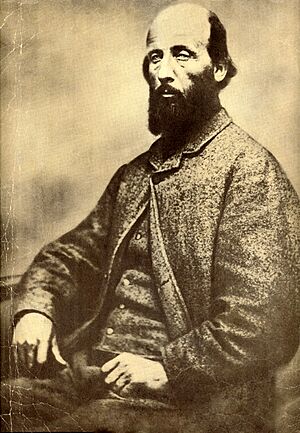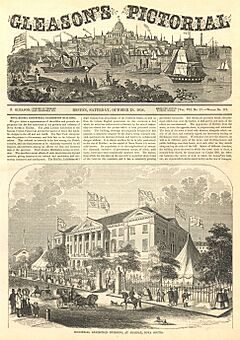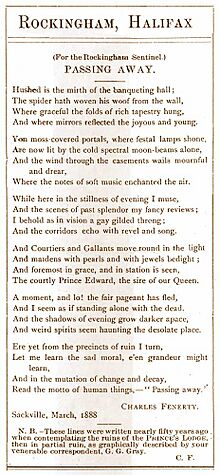Charles Fenerty facts for kids
Quick facts for kids
Charles Fenerty
|
|
|---|---|

Fenerty, c. 1870
|
|
| Born | c. January 1821 Upper Sackville, Nova Scotia
|
| Died | 10 June 1892 Lower Sackville, Nova Scotia, Canada
|
| Nationality | Canadian |
| Occupation | Farmer, writer (journalist articles), lumberman, lumber mill worker, sackville church board, wood measurer, census taker, health warden |
| Known for | The invention of wood pulp for the production of paper |
| Spouse(s) | Anne Hamilton |
| Children | He had no children |
| Awards | Winner of the Nova Scotia Industrial Exhibition "Poetry Contest". The title of the poem: Betula Nigra. He also awarded for making "The Best Wood Laths in Nova Scotia". |
Charles Fenerty (born around January 1821 – died June 10, 1892) was a Canadian inventor. He created a new way to make paper using wood pulp. This method was first used to make newsprint (paper for newspapers). Charles Fenerty was also a poet and wrote more than 32 poems.
Contents
Early Life of an Inventor
Charles Fenerty was born in Upper Falmouth, Nova Scotia. He was the youngest of three boys. All of them worked with their father, who was a lumberman and farmer.
During winter, the Fenerty family would cut down trees in the local forests. They then took the wood to their family's lumber mill. They shipped their lumber to Halifax, where it was used or sent to other places. The family also had a large farm. They sent most of their crops to markets in Halifax.
As a young man, Charles Fenerty started writing poems. His first known poem was called "The Prince's Lodge." He wrote it when he was 17 years old. It described an old, empty house near Halifax. This house was built many years before by Prince Edward Augustus, Duke of Kent and Strathearn.
How Paper Was Made from Wood
Each time Fenerty took wood and crops to Halifax, he would pass the paper mills. He sometimes stopped to watch how paper was made. Back then, paper was made from old rags, cotton, and other plant fibers. This method had been used for almost 2,000 years!
However, there wasn't enough supply of rags to meet the growing demand for paper. Europe even started sending less cotton to North America.
The Idea Takes Shape
Charles Fenerty learned that trees also have fibers. He talked about this with a naturalist named Titus Smith. Around 1838, when he was 17, Fenerty began trying to make paper from wood.
By 1844, he had perfected his method. This included bleaching the wood pulp to make it white. A family member later wrote that Charles Fenerty had shown a rough sample of his wood paper to a friend in 1840.
Sharing His Discovery
On October 26, 1844, Charles Fenerty took a sample of his new paper to the main newspaper in Halifax, the Acadian Recorder. He had written a letter on his wood paper. In the letter, he explained that his paper was made from spruce wood. He said it was as strong and white as regular paper. He believed that common forest trees like fir, spruce, or poplar could be used to make fine paper.
Other Inventors
Other people had also thought about using wood to make paper. In the 1700s, a French scientist named René Antoine Ferchault de Réaumur suggested it. Later, in 1800, Matthias Koops tried making paper by pressing straw and wood shavings together.
Around 1838, a German weaver named Friedrich Gottlob Keller also read Réaumur's ideas. He didn't know about Fenerty's work. In 1845, one year after Fenerty's letter, Keller got a patent in Germany for his method of making paper from ground wood pulp. Another person, Heinrich Voelter, bought Keller's patent. He started making paper, but it wasn't very successful at first. In Germany, Voelter is often given credit for being the first to make paper from wood pulp.
Poetry and Travels
Charles Fenerty was also a well-known poet. He published more than 35 poems. Some of his famous ones include "Betula Nigra" (about a Black Birch tree) and "Essay on Progress." In October 1854, he won first prize for "Betula Nigra" at the Nova Scotia Industrial Exhibition.
Fenerty traveled a lot in Australia from 1858 to 1865. He was there during the Australian gold rushes. After his travels, he returned to Halifax. He became involved with the Church and held several jobs in his community. He worked as a Wood Measurer, a Census Taker, a Health Warden, and a Tax Collector.
Later Life and Legacy
Fenerty's invention didn't get much attention at first. He never developed his process further or got a patent for it. However, his work marked the start of a new industry. Today, many people credit F. G. Keller as the original inventor of wood pulp paper.
Paper made from wood pulp slowly began to be used by paper mills. German newspapers were the first to use it. Then, other newspapers switched from using rags to wood pulp. Soon, there were mills all over Canada, the U.S., and Europe. By the end of the 1800s, almost all newspapers in the Western world were printed on wood pulp newsprint.
Charles Fenerty died on June 10, 1892, at his home in Lower Sackville, Nova Scotia. He passed away from the flu.
Recognition
On Canada Day in 1987, Canada Post honored Fenerty. They featured him on one of four stamps that celebrated Canadian inventors in communications.
See also
- Acadia Paper Mill
- Invention in Canada
- List of Canadian poets
- List of Canadian writers
- Paper engineering
- Pulpwood





